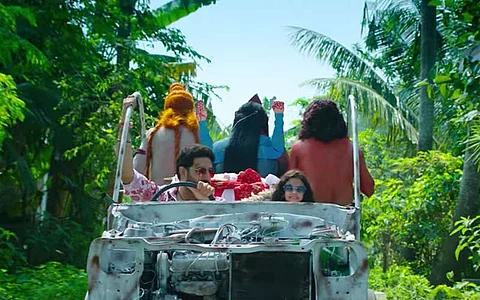
- In-Depth Stories
- Web Stories
- Reviews
- News
- FC Lists
- Interviews
- Features
- FC SpecialsFC Specials

Are we in the hills, or an industrial town? What are these floating settlements on the lake doing here? What is this place from where you can just drive off to a lush green countryside that looks like Bengal, Goa and Kerala exchanged notes? It's almost as if Ludo brings together multiple topographies, that almost clash with each other, in one place (where the lives of 12 main characters clash with each other's). The geography is sometimes confusing, if you think about it, but like a lot of things in an Anurag Basu film, you kind of don't question it because it's a fun (mostly) ride.
This place, wherever Ludo is set in, feels like many places (including some from Basu's last two films Barfi and Jagga Jasoos). A couple of shots make you think that you could be in Calcutta, with its architectural style. A cream coloured house with large green window with red borders forms the backdrop when we are in the flashback of the Rajkummar Rao character, and in a nocturnal version of the place, when Abhishek Bachchan's Bittu and the little girl Mini (Inayat Verma) meet for the first time.

Someone from Benaras might say it looks like Benaras, or Lucknow. Ludo doesn't spell out where we are, and the ambiguity allows it to be interpreted in different ways. We think we are in a place with bafflingly contradictory topographies, but we are really in Anurag Basu's mind-space, and he doesn't really care about geographic accuracy. There are nighttime shots of a typical hilly road, with shanties on one side and houses lit up in the valley to the left. In the next scene, we seem to be in a North Indian small town—with crowded streets, an ordinary looking bridge, small temples.

Everyone will agree that Barfi onwards, Basu has become a different filmmaker. He has become more of an expressionist, like Sanjay Leela Bhansali, less and less interested in 'realism' than in conjuring up surreal worlds. But Basu's is a different brand of surrealism than Bhansali, who has a concentrated and singleminded kind of aesthetic. Basu is more all over the place and chaotic and tries to give the audience different flavours. He's also more outdoorsy (even though he likes to work it out of a big movie set, as he says in this interview). In Barfi, he could play around with locations in and around Darjeeling and a completely studio-produced Calcutta because the characters were from those places. In Jagga Jasoos, he got a bigger canvas, so it had Darjeeling (doubling as Manipur), Calcutta and Africa.

The box office failure of Jagga Jasoos would've meant that Basu had to downsize his budget—but not necessarily his vision. Ludo is not completely fantastical in that we are not in a place where mountains, deserts and seas co-exist, but it's quixotic on a more small-scale level. We have Rao breakdancing in what looks like a ghat. A fair pops up near the one-room flat by the railway-line where Bittu lives with the little girl. It has a big, glowing nagordola. The same place, from another side, looks like an industrial town— in what is probably a nod to Basu's hometown Bhilai, painterly silhouettes of smoking chimneys of a factory form the backdrop of a scene between Rahul (Rohit Saraf) and Shreeja (Pearle Manney). Unless I was imagining things, there's a shot of a grand, old temple on the other side of the river. It's bathed in golden sunlight in the morning. In that shot, it almost seems like an ancient temple town.

Basu has his obsessions, which are probably irrational, but they fit right into the mad, mad worlds of Barfi, Jagga and Ludo. There is a recurring motif of two characters crossing a stream in a forest in all three films. In all three films, the characters almost take a detour from the main setting and arrive at this spot for a break. In Ludo, it's when Bittu and the little girl have a little adventure when they are on their way to collect the ransom money. They meet bohurupees on their way—another Basu motif; in Barfi and Jagga, you had folk performers showing up in traditional masks.

There's also a bit of the Africa portions from Jagga Jasoos in Ludo when Akash (Aditya Roy Kapur) and Shruti (Sanya Malhotra) are driving their car through a barren land. There's almost nothing else except dry hills and windmills. Where the hell are we?
It's clear that Basu thinks pictorially, and it's almost as if the locations are retrofitted to whatever his imagination throws up. If that means repeating himself, so be it. If anything, it adds to the whimsy. He keeps going back to that forest and stream maybe because he has a fondness for the hill stations in West Bengal.

Ludo's geographic fluidity extends to the way the film treats physical space as well. We zoom out of Akash's stand-up routine to the story of how he met Shruti in a cafe like we are going to another room, with two Akashs in the same frame. The film does certain visual manipulations when it's looking at its characters like tokens in a game of Ludo. Basu gets a god's eye view of the proceedings. He sits on a hill top next to a small temple and rolls the dice on his wonderland.